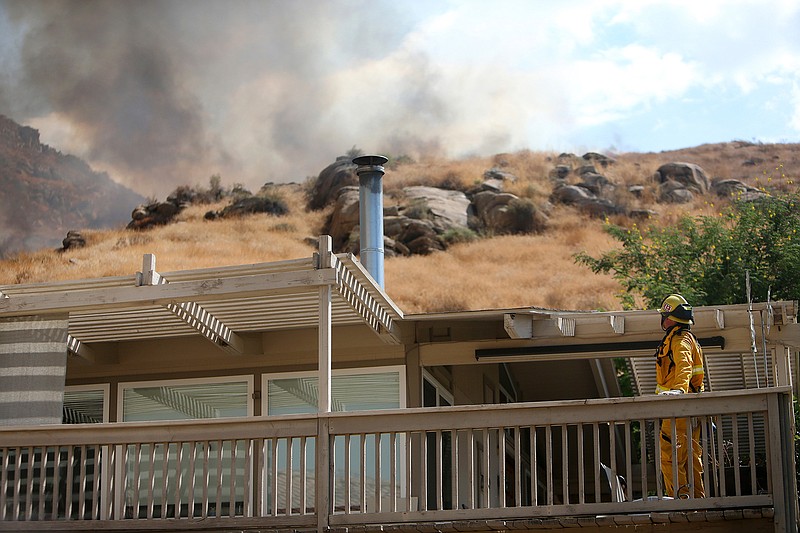The smoke from massive wildfires hangs like fog over large parts of the West, an irritating haze that has caused health concerns, forced sports teams to change schedules and disrupted life from tiny Seeley Lake, Montana, to Seattle.
Air quality has been rated unhealthy in cities across the region because of the blazes that show no signs of abating. Officials said Friday one of the worst wildfire seasons in the U.S. in terms of area burned is likely to continue scorching Western states and blanketing large swaths with smoke until cooler weather patterns with rain or snow arrive later in the fall.
People from small western towns to the populous Bay Area in California-which was experiencing unhealthy air Friday due in part to wildfires burning nearby-have had enough.
"Last night, I went to sleep with the windows open and woke up with a stomach ache and a headache," said Tresa Snow, who owns a hair salon in Brookings, Oregon, near a large wildfire. "I knew before I could even smell it that the fire was back. And you can hear my voice, kind of raspy. We're all kind of like that."
She said business has been down throughout town near the California border. "Businesses are closing because they don't have their help. People have been evacuating."
In the run-up to the long U.S. Labor Day weekend several high school football teams changed their season-opening football games to avoid the smoke, and other athletic events have been postponed. Football teams have been practicing inside gymnasiums whenever possible. The poor air quality has also caused the cancellation of some performances at the Oregon Shakespeare Festival in Ashland and the Cycle Oregon Classic Ride, a 400-mile bicycle event scheduled for later this month.
In early August smoke from wildfires in British Columbia pushed down into western Washington, choking the region and prompting health officials to tell people in the Seattle area to keep children, the elderly and people with respiratory problems to stay inside.
Smoke has affected the western Montana town of Seeley Lake to such a degree that Missoula County health officials urged people to leave to escape the pollution weeks before Tuesday's order to evacuate part of the town due to the encroaching fire.
"I would like for people to take air quality as seriously as they take water quality, because you have to breathe," air quality specialist Saran Coefield said Friday.
The air quality in Seeley Lake had hourly pollution readings classified as hazardous in 26 days in August, in many cases topping out the ability of the monitor to measure the pollution. The air quality was considered hazardous Friday morning, as well.
"There aren't even the correct health categories to describe what they're seeing," Coefield said.
Most of the smoke entering Washington state this year is coming from neighboring states and British Columbia, said Joye Redfield-Wilder of the state Department of Ecology, in Yakima.
"I'm smelling smoke in my office right now," she said.
Ranil Dhammapala, who studies air quality for the Washington state Department of Ecology in Olympia, said smoke from wildfires has been more widespread across the whole state this year than in a normal year, but not as severe in particular areas as in several past years.
"We didn't see it get that bad this year in a single location," Dhammapala said, but noted
that the wildfire season is still going on.
In Northern California, a wildfire burning near the town of Oroville destroyed 20 homes. The California Department of Forestry and Fire Protection said the blaze about 70 miles north of Sacramento had consumed nearly 6 square miles. It's threatening 500 homes.
Also in California, the nation's largest retardant aircraft earlier this week saw its first action of the season when the converted 747 jet capable of carrying 19,000 gallons started making drops.
The National Interagency Fire Center said more than 25,000 firefighters and fire support personnel are spread out across the Western U.S. fighting 56 large uncontained wildfires, 21 of them in Montana and 17 in Oregon.
Fire center spokesman Jessica Gardetto said Friday that besides one of the most destructive wildfire seasons, 2017 is turning into one of the longest, starting in the spring in Oklahoma, Arizona and New Mexico.
"Some of these firefighters have been working on fires for six months now," she said.
The 10,600 square miles that have burned at this point rank the 2017 wildfire season as the third worst in the last decade. The area burned is about 2,600 square miles above the 10-year average.

